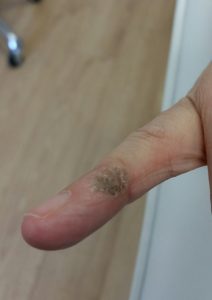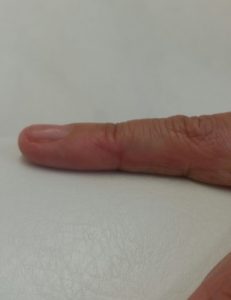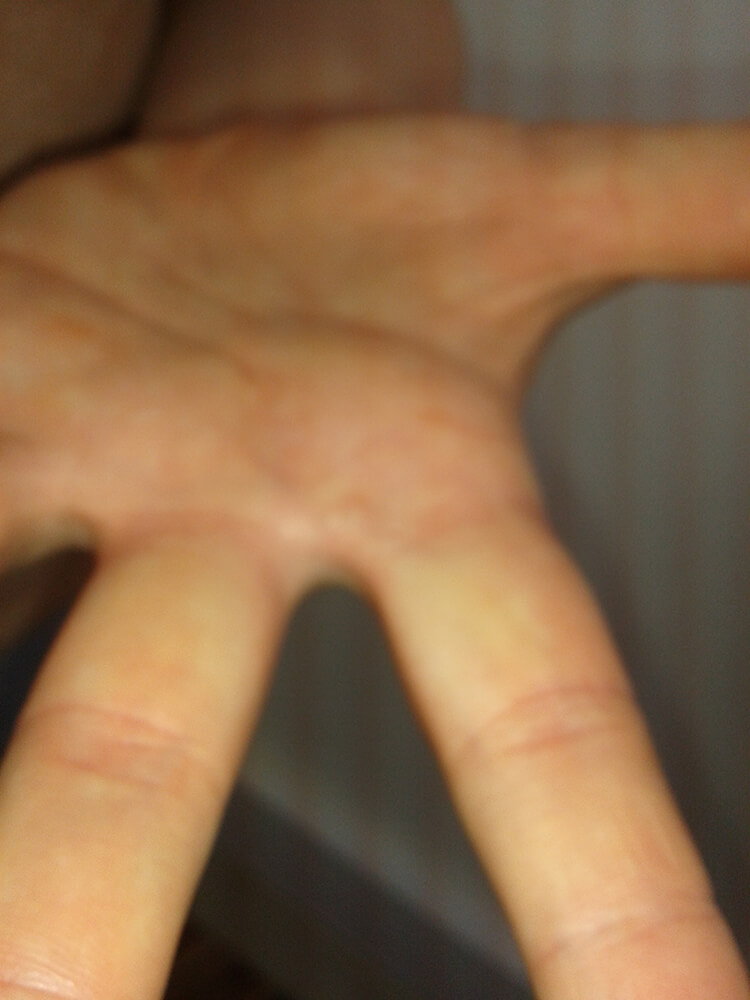Wart Removal: Common, Plane, Filiform, Periungal
Wart removal at Inskin is quick and effective and scar free.

Common wart before treatment

After 1 treatment

Completely gone after 2 treatments
Warts are unsightly rough growths. Some are caused by the human papilloma virus (HPV), of which there are over 100 different types. Any area of the skin could be affected, but warts are more commonly found on the hands (especially the fingers), feet and face. Those found on the soles of the feet are known as verruca’s and are also caused by the HP Virus.
Up to one in 10 people will have a wart at some point in their life, most commonly in childhood or adolescence. Warts and verrucas are usually harmless but can be contagious and usually spread from direct skin contact or in damp places, like swimming pools and communal showers. If you scratch a wart, the viral particles may spread to other areas of your skin.
Different types of warts vary in appearance and size, ranging from 1mm up to 5cm in the case of a Seborrheic Keratosis. Wart removal is effectively and successfully achieved with Advanced techniques with short wave diathermy (thermolysis).
Different types of Wart Removal:
Filiform

an established filiform can often look white in colour, note the protrusions

skin coloured filiforms can initially look a bit like a skin tag until they establish
These are quite unique and like no other wart in their appearance. They tend to appear on the neck and face and in particular around the eyelids, lips, and neck, making them hard to hide as well as accept. They are not your normal raised and round warts, instead they appear to look more like small twigs or branches that are growing out of your skin. Their appearance is long, narrow and they have a flesh colour to them. What is most noticeable about Filiform warts is the speed and aggression with which they attack. They usually spread quickly and if left untreated can get worse over time. They can very easily and quickly be removed in one treatment
Seborrheic
These warts are different in that they are not caused by the HPV virus. They are a flat thick build up of epidermal cells with a rough texture and sometimes resembling a miniature cowpat. They can be skin colour through to black, and can grow up to two inches across. They’re sometimes referred to as ‘Senile’ warts, as they are more associated with age. Older people sometimes have them on their face, but they are more common on the torso. If there are many in one area they can even merge together. The longer they are left untreated the more established they become, as they set down fibrous attachments into the skin. Once removed though, new fresh skin will emerge. These are 1 of 3 blemishes which we recommend are treated sooner rather than later. The others being blood spots and age spots.
Plane
Plane wart removal is the simplest of all. These are usually small, smooth and skin or brownish coloured lesions, which are slightly raised from the skin. They usually occur on the face and outer surface of hands. They’re most common in children and young adults.
Common
These are firm, raised growths with a rough surface, which sometimes resemble a very small cauliflower. They are most commonly found on the backs of your hands, fingers, toes and on your knees. They also often feature a pattern of tiny black dots sometimes called seeds. These are small, clotted blood vessels. These are viral and therefore transmitted by direct or indirect touch. Children and young adults are more likely to develop common warts, as are people who have weakened immune systems. Common warts usually disappear on their own but this may take a couple of years. So, many people choose to remove them because they find them irritating or embarrassing. More than one treatment session may be required.
Periungal

Periungal warts on two fingers

After 1 treatment

After 2 treatments, warts have gone
These are warts around or under the nail. They generally start out as small raised bumps that are not easily seen by the naked eye. This is especially true when they begin to form underneath the edge of the finger or toe nail. However, as they grow patients soon notice rough-looking bumps with non-uniform edges. Periungual warts tend to take on the appearance of small cauliflowers as they grow and spread. Sometimes they can occur in clusters. Left untreated, periungual warts underneath the nail can begin to push up on it and cause mild to moderate pressure. The pressure becomes painful if the nail experiences even the lightest touch. Should these warts grows large enough, its size could even cause the nail to permanently detach. Although this is uncommon, it can happen, and is likely to cause permanent nail damage and scarring. More than one treatment session may be required
please be advised that we do not treat genital warts
why choose inskin clinic?
Inskin Group are a small specialist team of doctors, nurses, clinical professionals providing personally tailored, targeted treatments at realistic prices.
We take great pride in the services we offer and will make sure you will receive the best possible care and treatment when you are with us.
Book a consultation for treatments such as Wart Removal at the Inskin Clinic in Altrincham, Manchester by getting in touch with our dedicated team on 0161 637 7626 or, by filling out our enquiry form and a member of our team will aim to get back to you straight away.
Alternatively, you can check out our offers page which details all the great deals we have available on a wide range of treatments.
Prices
- one common or periungal wart £105 (from, depending on size) additional treatments £75
- 2 or more common or periungal warts £165 (from, depending on amount) additional treatments £125
- Filiform warts - x 1 £130
- Filiform Warts x 2-5 £240
- seborrheic keratosis £priced as time required to treat - see dedicated page






